Introduction to Integrated Circuits(IC’s)
An integrated
circuit can be defined generally as an arrangement of multifunction semiconductor devices. It consists of a
single-crystal chip of silicon, nearly 1.5 mm2 in cross-section,
containing both active and passive elements and their interconnections.
 Earlier
electronic circuits were assembled from individual components (e.g. resistor,
capacitor, diode, transistors etc.) joined by wires. The sizes were further
reduced by the use of printed circuit boards. The interconnection between
various components is made through their metal strips formed on an insulating sheet.
Such circuits are known as discrete
circuits because each component of the circuit is separate from others.
Main disadvantages of discrete circuits
are that
Earlier
electronic circuits were assembled from individual components (e.g. resistor,
capacitor, diode, transistors etc.) joined by wires. The sizes were further
reduced by the use of printed circuit boards. The interconnection between
various components is made through their metal strips formed on an insulating sheet.
Such circuits are known as discrete
circuits because each component of the circuit is separate from others.
Main disadvantages of discrete circuits
are that - they
occupy large space
- large
number of soldered joints are less reliable
In an integrated circuit, various components
such as resistors, capacitors, diodes
etc. are fabricated on the same semiconductor chip. The reliability of
the circuit is increased as the active and passive components are built in the
same crystal. The most noticeable characteristic of an IC is its size. It is
thousands of times smaller than a semiconductor structure built in the usual
manner with discrete components
Our world is full of
integrated circuits. You find several of them in computers. For example, the
microprocessor is an integrated circuit that processes all information in the
computer. It keeps track of what keys are pressed and if the mouse has been
moved. It counts numbers and runs programs, games and the operating system.
Integrated circuits are also found in almost every modern electrical device
such as cars, television sets, CD players, cellular phones, etc.
Classification of Integrated Circuits
Integrated circuits can be divided into two general classes,
linear (analogue) and digital. Typical examples of linear integrated circuits
are operational amplifiers whereas typical examples of digital integrated
circuits are the logic gates and microprocessors that you met in the
earlier chapters. It’s worth noting that a number of integrated circuit
devices bridge the gap between the analogue and digital world. Such devices
include analogue to digital converters (ADC), digital to analogue converters
(DAC), and timers.
Digital integrated circuits can contain anything from one to
millions of logic gates, flip-flops, multiplexers, and other circuits in a
few square millimeters. The small size of these circuits allows high speed, low
power dissipation, and reduced manufacturing
cost compared with board-level integration.
These digital ICs, typically microprocessors, DSPs, and micro controllers, work
using binary mathematics to process "one" and "zero"
signals.
Analog ICs, such as sensors, power
management circuits, and operational
amplifiers, work by processing continuous signals. They perform functions like amplification, active filtering, demodulation, and mixing. Analog ICs ease the burden on
circuit designers by having expertly designed analog circuits available instead
of designing a difficult analog circuit from scratch.
Pin Numbering for various IC packages
The pins are numbered
anti-clockwise around the IC (chip) starting near the notch or dot.
Often, but not always, GROUND
and VCC are at opposite corners GROUND is usually on the lower left. VCC is usually on the upper right.
 Examples of through-hole and surface-mounted devices. The DIP is
larger than the SOIC with he same number of leads.
Examples of through-hole and surface-mounted devices. The DIP is
larger than the SOIC with he same number of leads.
Briefly looks some IC packages and their pin numbering,
SIP package
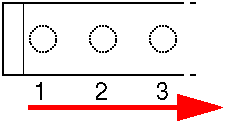
This numbering method is used for these packages:
- SIP (Single In-line Package)
- SIL (Single In-Line)
DIP package
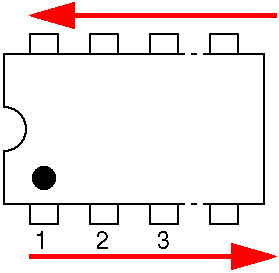
This numbering method is used for these packages:
- DIP (Dual In-line Package)
- DIL (Dual In-Line)
- SDIP (Shrink Dual In-line Package)
- SO (Small Outline)
- SOIC (Small Outline Integrated Circuit)
- SOJ (Small Outline J-leaded)
- SOP (Small Outline Package)
- SSOP (Shrink Small Outline Package)
- TSOP (Thin Small Outline Package)
ZIP package
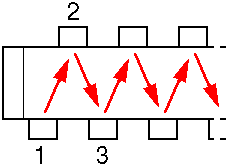
This numbering method is used for these packages:
- ZIP (Zig-zag In-line Package)
PGA package
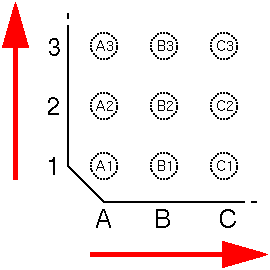
This numbering method is used for these packages:
- PGA (Pin Grid Array)
- BGA (Ball Grid Array)
PLCC package
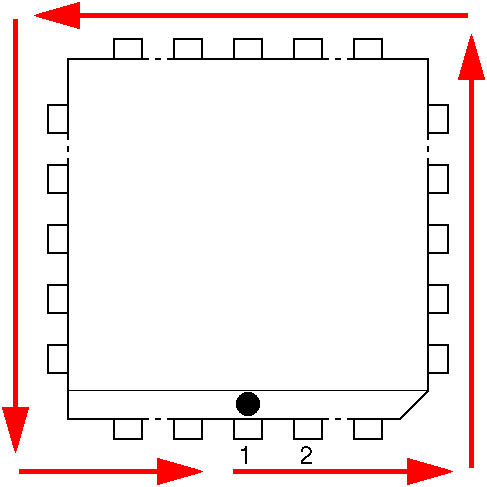
This numbering method is used for these packages:
- PLCC (Plasic Leaded Chip Carrier)
- QFP (Quad Flat Package) used by Motorola, Freescale
- PQFP (Plasic Quad Flat Package) used by Motorola, Freescale
QFP package
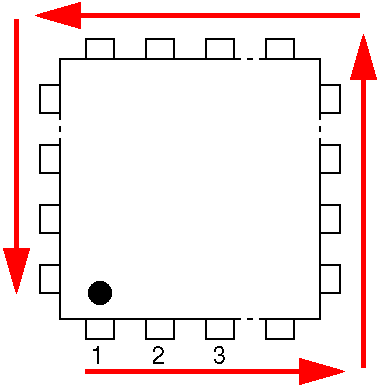
This numbering method is used for these packages:
- QFP (Quad Flat Package)
- PQFP (Plasic Quad Flat Package)
- PLCC (Plasic Leaded Chip Carrier)

No comments:
Post a Comment